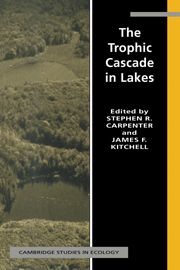Book contents
- Frontmatter
- Contents
- Contributors
- Preface
- 1 Cascading trophic interactions
- 2 Experimental lakes, manipulations and measurements
- 3 Statistical analysis of the ecosystem experiments
- 4 The fish populations
- 5 Fish behavioral and community responses to manipulation
- 6 Roles of fish predation: piscivory and planktivory
- 7 Dynamics of the phantom midge: implications for zooplankton
- 8 Zooplankton community dynamics
- 9 Effects of predators and food supply on diel vertical migration of Daphnia
- 10 Zooplankton biomass and body size
- 11 Phytoplankton community dynamics
- 12 Metalimnetic phytoplankton dynamics
- 13 Primary production and its interactions with nutrients and light transmission
- 14 Heterotrophic microbial processes
- 15 Annual fossil records of food-web manipulation
- 16 Simulation models of the trophic cascade: predictions and evaluations
- 17 Synthesis and new directions
- References
- Index
11 - Phytoplankton community dynamics
Published online by Cambridge University Press: 06 August 2010
- Frontmatter
- Contents
- Contributors
- Preface
- 1 Cascading trophic interactions
- 2 Experimental lakes, manipulations and measurements
- 3 Statistical analysis of the ecosystem experiments
- 4 The fish populations
- 5 Fish behavioral and community responses to manipulation
- 6 Roles of fish predation: piscivory and planktivory
- 7 Dynamics of the phantom midge: implications for zooplankton
- 8 Zooplankton community dynamics
- 9 Effects of predators and food supply on diel vertical migration of Daphnia
- 10 Zooplankton biomass and body size
- 11 Phytoplankton community dynamics
- 12 Metalimnetic phytoplankton dynamics
- 13 Primary production and its interactions with nutrients and light transmission
- 14 Heterotrophic microbial processes
- 15 Annual fossil records of food-web manipulation
- 16 Simulation models of the trophic cascade: predictions and evaluations
- 17 Synthesis and new directions
- References
- Index
Summary
Introduction
Limnologists have long appreciated the potential importance of grazing to phytoplankton community composition (Reynolds, 1984a). At certain times during seasonal succession, grazers have clear-cut effects on algal assemblages (Lampert et al., 1986; Sommer et al., 1986; Vanni & Temte, 1990). Grazers affect phytoplankton communities through several mechanisms, including direct suppression of edible algae, enhancement of inedible algae via nutrients excreted by grazers, and shifts in the outcome of competition caused by grazer effects on nutrient supply ratios (Sterner, 1989). The complexity of the mechanisms may explain the multifarious and individualistic outcomes of field experiments on zooplankton–phytoplankton interactions (Lehman & Sandgren, 1985; Bergquist & Carpenter, 1986; Elser et al., 1986a; Vanni & Temte, 1990).
Organism size may provide important organizing principles for understanding zooplankton–phytoplankton interactions (Peters & Downing, 1984). With the exception of calanoid copepods capable of feeding selectively on certain algae, the size of the herbivore largely determines the range of algal sizes upon which it can feed (Burns, 1968; Reynolds, 1984a). Feeding rates also depend on herbivore size (Peters & Downing, 1984). Size-selective predation by fishes strongly influences size structure of the herbivore community (Brooks & Dodson, 1965; Chapter 8). Therefore, size-structured interactions of zooplankton and phytoplankton have important implications for the trophic cascade (Bergquist et al., 1985).
We developed a simulation model to determine the potential effects of herbivore size on phytoplankton size structure, biomass, and primary production (Carpenter & Kitchell, 1984; Chapter 17).
- Type
- Chapter
- Information
- The Trophic Cascade in Lakes , pp. 189 - 209Publisher: Cambridge University PressPrint publication year: 1993
- 6
- Cited by



